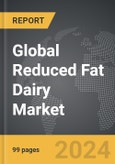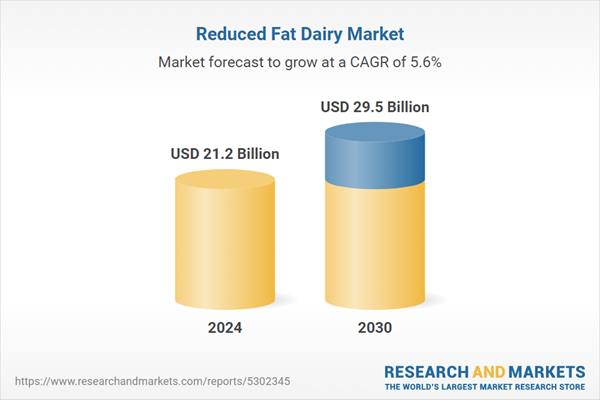Global Reduced Fat Dairy Market - Key Trends & Drivers Summarized
What Is Reduced Fat Dairy & Why Is It Gaining Popularity in the Food Industry?
Reduced fat dairy products are dairy foods that have had their fat content lowered while maintaining essential nutrients and flavors. This category includes products such as reduced-fat milk, yogurt, cheese, and ice cream, which provide a healthier alternative to their full-fat counterparts. The appeal of reduced fat dairy products lies in their ability to deliver the same taste and texture that consumers enjoy while significantly reducing calorie and fat intake. These products are increasingly popular among health-conscious consumers looking to maintain a balanced diet without sacrificing the enjoyment of dairy.The demand for reduced fat dairy has surged in response to growing health concerns regarding obesity, heart disease, and dietary fat intake. As more individuals become aware of the benefits of healthier eating habits, there is a clear shift towards products that offer lower fat content. The emphasis on wellness and preventive health has made reduced fat dairy an attractive choice for families and individuals aiming to improve their dietary profiles while still enjoying familiar dairy flavors.
How Does Reduced Fat Dairy Contribute to Healthier Diets & Lifestyle Choices?
Reduced fat dairy contributes to healthier diets by providing essential nutrients such as calcium, protein, and vitamins while significantly lowering fat and calorie content. For example, reduced-fat milk retains the same calcium levels as whole milk, making it an excellent choice for those looking to strengthen bones without the additional saturated fat. The lower calorie count of reduced fat dairy products supports weight management efforts, allowing consumers to enjoy their favorite dairy foods while adhering to calorie-conscious diets.Additionally, reduced fat dairy products often contain beneficial probiotics, especially in yogurts, which can enhance gut health and support digestive wellness. This combination of taste, nutrition, and health benefits positions reduced fat dairy as a valuable component of a balanced diet. By providing options that align with health trends, such as lower saturated fat intake and increased nutrient density, reduced fat dairy encourages consumers to make healthier lifestyle choices.
How Are Technological Advancements Shaping the Development of Reduced Fat Dairy Products?
Technological advancements have played a significant role in improving the formulation, taste, and texture of reduced fat dairy products. One major innovation is the development of advanced processing techniques that allow manufacturers to lower fat content while preserving the creaminess and mouthfeel typically associated with full-fat dairy. Techniques such as membrane filtration and ultrafiltration enable the concentration of proteins and other solids, enhancing the texture and taste of reduced fat products.Another significant advancement is the incorporation of flavoring agents and emulsifiers that help maintain sensory attributes in reduced fat dairy items. These additives can enhance creaminess and overall flavor without adding extra fat or calories, making it easier for manufacturers to produce appealing products that compete with their full-fat counterparts.
Furthermore, advancements in fortification and enrichment techniques have allowed manufacturers to create reduced fat dairy products that provide additional health benefits. For example, products can be fortified with vitamins A and D, calcium, and probiotics to enhance their nutritional profiles and appeal to health-conscious consumers. These technological innovations not only improve the quality and acceptance of reduced fat dairy products but also help expand their market reach across diverse consumer segments.
What Factors Are Driving Growth in the Reduced Fat Dairy Market?
The growth in the reduced fat dairy market is driven by several factors, including increasing health consciousness among consumers, rising obesity rates, the expansion of the health and wellness trend, and advancements in dairy processing technologies. As public awareness of the importance of nutrition and healthy eating continues to rise, consumers are actively seeking out lower-fat options to manage their weight and reduce their risk of chronic diseases. This trend has made reduced fat dairy products a preferred choice for individuals and families aiming to improve their overall dietary habits.The expanding health and wellness trend has also led to greater demand for products that offer functional benefits, such as enhanced nutrition and lower calories. Consumers are increasingly interested in foods that contribute to their health goals, making reduced fat dairy products particularly appealing. Additionally, the growing popularity of meal planning and preparation has prompted the food industry to create convenient, healthy options that align with consumer preferences.
Technological advancements in dairy processing have further supported the growth of the reduced fat dairy market by improving product quality and taste. Manufacturers are better equipped to produce reduced fat products that maintain the desirable attributes of full-fat dairy, increasing consumer acceptance and demand. Emerging markets in Asia-Pacific and Latin America are witnessing a rise in the consumption of dairy products, creating new opportunities for reduced fat dairy manufacturers. With ongoing innovations, expanding applications in the health food sector, and rising consumer demand for nutritious alternatives, the reduced fat dairy market is poised for sustained growth, driven by evolving dietary preferences and health trends.
Report Scope
The report analyzes the Reduced Fat Dairy market, presented in terms of units. The analysis covers the key segments and geographic regions outlined below.Segments: Segment (Reduced Fat Dairy).
Geographic Regions/Countries: World; United States; Canada; Japan; China; Europe (France; Germany; Italy; United Kingdom; Spain; Russia; and Rest of Europe); Asia-Pacific (Australia; India; South Korea; and Rest of Asia-Pacific); Latin America (Argentina; Brazil; Mexico; and Rest of Latin America); Middle East (Iran; Israel; Saudi Arabia; United Arab Emirates; and Rest of Middle East); and Africa.
Regional Analysis
Gain insights into the U.S. market, valued at $5.5 Billion in 2024, and China, forecasted to grow at an impressive 8.6% CAGR to reach $6.7 Billion by 2030. Discover growth trends in other key regions, including Japan, Canada, Germany, and the Asia-Pacific.Why You Should Buy This Report:
- Detailed Market Analysis: Access a thorough analysis of the Global Reduced Fat Dairy Market, covering all major geographic regions and market segments.
- Competitive Insights: Get an overview of the competitive landscape, including the market presence of major players across different geographies.
- Future Trends and Drivers: Understand the key trends and drivers shaping the future of the Global Reduced Fat Dairy Market.
- Actionable Insights: Benefit from actionable insights that can help you identify new revenue opportunities and make strategic business decisions.
Key Questions Answered:
- How is the Global Reduced Fat Dairy Market expected to evolve by 2030?
- What are the main drivers and restraints affecting the market?
- Which market segments will grow the most over the forecast period?
- How will market shares for different regions and segments change by 2030?
- Who are the leading players in the market, and what are their prospects?
Report Features:
- Comprehensive Market Data: Independent analysis of annual sales and market forecasts in US$ Million from 2024 to 2030.
- In-Depth Regional Analysis: Detailed insights into key markets, including the U.S., China, Japan, Canada, Europe, Asia-Pacific, Latin America, Middle East, and Africa.
- Company Profiles: Coverage of players such as Amul, Arla Foods Amba, Dairy Farmers of America, Danone, Fonterra Co-Operative Group Limited and more.
- Complimentary Updates: Receive free report updates for one year to keep you informed of the latest market developments.
Some of the 53 companies featured in this Reduced Fat Dairy market report include:
- Amul
- Arla Foods Amba
- Dairy Farmers of America
- Danone
- Fonterra Co-Operative Group Limited
- Megmilk Snow Brand Co. Ltd
- Nestle
Tariff Impact Analysis: Key Insights for 2025
Global tariff negotiations across 180+ countries are reshaping supply chains, costs, and competitiveness. This report reflects the latest developments as of April 2025 and incorporates forward-looking insights into the market outlook.The analysts continuously track trade developments worldwide, drawing insights from leading global economists and over 200 industry and policy institutions, including think tanks, trade organizations, and national economic advisory bodies. This intelligence is integrated into forecasting models to provide timely, data-driven analysis of emerging risks and opportunities.
What’s Included in This Edition:
- Tariff-adjusted market forecasts by region and segment
- Analysis of cost and supply chain implications by sourcing and trade exposure
- Strategic insights into geographic shifts
Buyers receive a free July 2025 update with:
- Finalized tariff impacts and new trade agreement effects
- Updated projections reflecting global sourcing and cost shifts
- Expanded country-specific coverage across the industry
Table of Contents
Companies Mentioned (Partial List)
A selection of companies mentioned in this report includes, but is not limited to:
- Amul
- Arla Foods Amba
- Dairy Farmers of America
- Danone
- Fonterra Co-Operative Group Limited
- Megmilk Snow Brand Co. Ltd
- Nestle
Table Information
| Report Attribute | Details |
|---|---|
| No. of Pages | 99 |
| Published | April 2025 |
| Forecast Period | 2024 - 2030 |
| Estimated Market Value ( USD | $ 21.2 Billion |
| Forecasted Market Value ( USD | $ 29.5 Billion |
| Compound Annual Growth Rate | 5.6% |
| Regions Covered | Global |









